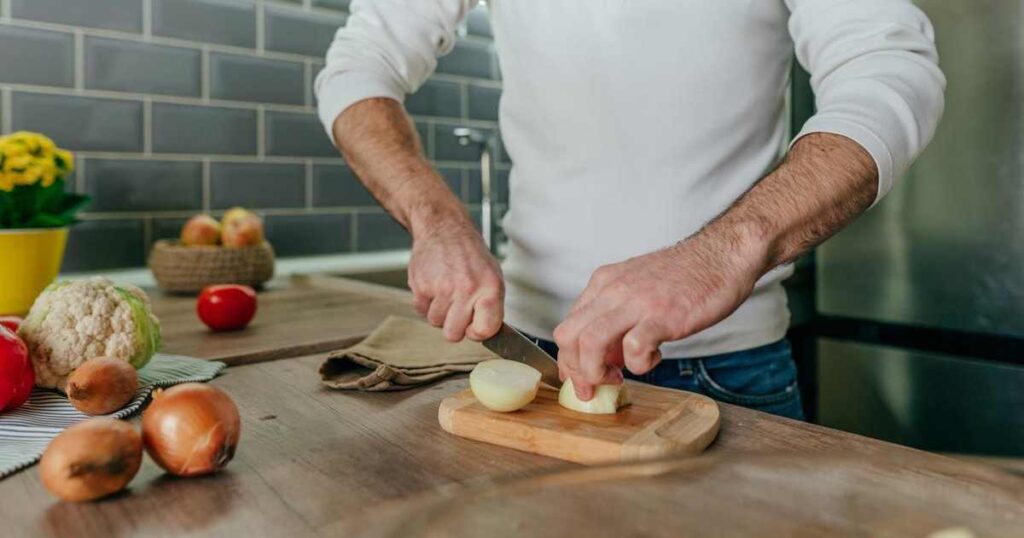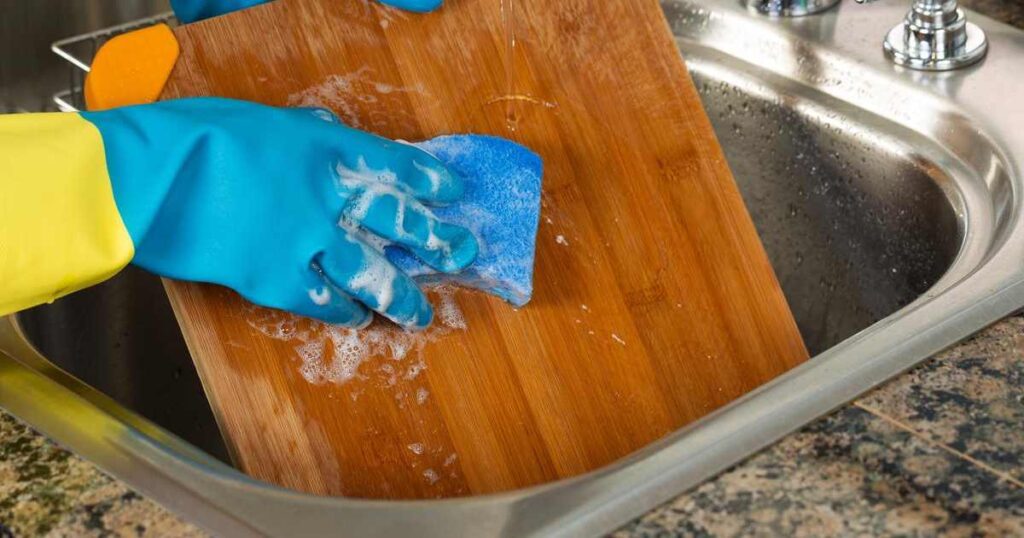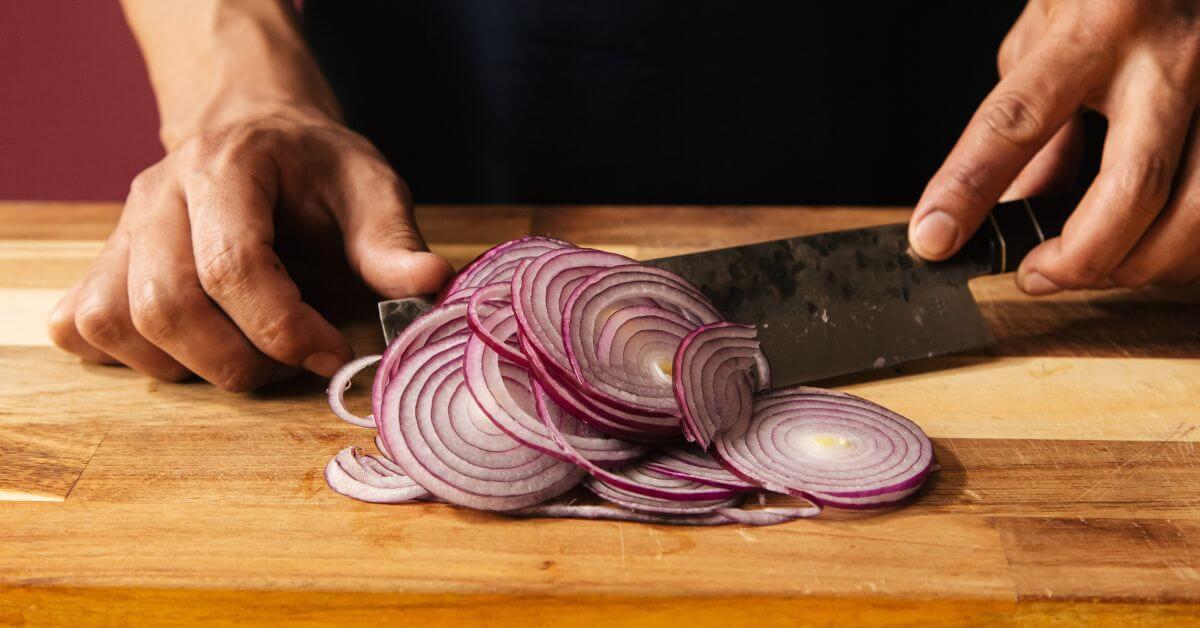Have you ever noticed why your cutting board smells like onion, no matter how often you wash it? Many home cooks commonly face this problem. Not only is it unpleasant, but it can also affect the taste of your food.
In this article, we’ll explore the reasons why your cutting board smells like onion and what you can do to fix it. From proper cleaning techniques to natural remedies, we’ll cover everything you need to know to keep your cutting board fresh and odour-free. So, if you’re tired of dealing with a stinky cutting board, keep reading to find out how to fix it!
Table of Contents
ToggleWhy Does Your Cutting Board Smell Like Onion

Have you ever noticed that your cutting board smells strongly of onions, even after washing it multiple times? Using a cutting board with a strong odour can be frustrating, but it’s essential to understand why this happens. This section explores the science behind onion odour and why cutting boards absorb odours.
The Science Behind Onion Odor
The pungent aroma of onions is caused by a gas called syn-propanethial-S-oxide, released when the onion is cut. This gas is volatile, quickly evaporating and spreading through the air. When the gas comes in contact with a surface, it can be absorbed and trapped in the tiny pores of the material.
Why Cutting Boards Absorb Odors
Cutting boards are particularly susceptible to absorbing onion odour because they are often made of porous materials such as wood or plastic. These materials have tiny crevices and pores that can trap the onion gas and hold onto it for an extended period. The odour can still linger even after washing the cutting board with soap and water.
But it’s not just onions that can cause odour absorption on cutting boards. Other foods, such as garlic, fish, and spices, can also leave a strong odour on the board. So, if you’re wondering why your cutting board smells like onion, it’s not just the onions – it’s the porous material holding onto the odour.
You can also read: Are Red Potatoes Naturally Red? The Truth About Red Potatoes
The Risks of an Unsanitized Cutting Board
Using an unsanitized cutting board can pose serious health risks, as bacteria can quickly grow and spread on the surface. In this section, we’ll explore the dangers of bacteria growth on a cutting board, the risks of cross-contamination, and the importance of proper cleaning.
When you use a cutting board to prepare raw meat, poultry, or fish, cleaning the board thoroughly before using it for other foods is essential. This is because raw meat and fish can contain harmful bacteria such as salmonella, E. coli, and Listeria, which can quickly multiply on a cutting board that is not properly sanitized.
Cross-contamination is another risk when using an unsanitized cutting board. If you use the same board to cut raw meat and then use it to chop vegetables or other food items, the bacteria from the raw meat can transfer onto the other foods, potentially causing illness.
To prevent these risks, it’s essential to properly clean and sanitize your cutting board after each use. This can be done by washing the board with hot, soapy water or placing it in the dishwasher. Additionally, using a separate cutting board for raw meats and fish can reduce the risk of cross-contamination.
The Best Cutting Board Materials to Avoid Onion Odor
If you’re tired of dealing with a cutting board that constantly smells like onions, certain materials can help to resist odour absorption. In this section, we’ll explore the best cutting board materials to avoid onion odour and the pros and cons of each.
Bamboo
One material that is often recommended for its resistance to odour absorption is bamboo. Bamboo cutting boards are made from a natural, lightweight, and durable material. They are also resistant to bacteria growth, making them a popular choice for many home cooks. However, bamboo boards can be prone to knife marks and require more maintenance than other materials.
Plastic
Another material that is often recommended is plastic. Plastic cutting boards are non-porous and less likely to absorb odours and bacteria. They are also easy to clean and are often dishwasher-safe. However, plastic cutting boards can be less durable than other materials and may need to be replaced more frequently.
Wood
Wooden cutting boards can also be a good choice for resisting onion odour, but choosing the right type of wood is essential. Hardwoods such as maple, walnut, and cherry are often recommended, as they are dense and have fewer pores than softer woods. However, wooden cutting boards can require more maintenance than other materials and may not be dishwasher-safe.
How to Remove Onion Smell from Your Cutting Board

This section explores removing the onion smell from your cutting board using household ingredients and commercial products.
Baking Soda
One effective method for removing onion odour is to use baking soda. Sprinkle baking soda onto the cutting board and scrub with a damp sponge or cloth. Rinse the board thoroughly with water and dry it with a clean towel.
Vinegar
Another household ingredient that can help to remove the onion odour is vinegar. Mix white vinegar and water in equal parts, and use a sponge or cloth to wipe down the cutting board. Rinse the board with water and dry thoroughly.
Commercial Product
Several products are designed to remove odour from cutting boards for a commercial solution. Look for products made with natural ingredients and safe for use on food surfaces.
Overall, several natural and commercial methods can help to remove the onion smell from your cutting board. Using these methods regularly and properly maintaining your cutting board ensures it remains clean, odour-free, and safe.
How to Prevent Onion Smell on Your Cutting Board
Preventing the onion smell on your cutting board is vital to keeping your kitchen clean and safe. This section explores practical methods for preventing the onion smell on your cutting board.
Proper storage of cutting boards: One way to prevent onion odour on your cutting board is to store it properly. After each use, clean the cutting board thoroughly and dry it completely before storing it in a dry and well-ventilated area.
Tips for avoiding odour absorption: Another way to prevent onion odour on your cutting board is to avoid odour absorption in the first place. One tip is to use a separate cutting board for onions and other strong-smelling foods. You can also use a plastic or glass cutting board, as these materials are less likely to absorb odours.
Seasoning your cutting board: Seasoning your cutting board with oil can help to prevent odours from penetrating the wood. Rub a food-safe oil, such as mineral or coconut oil, onto the board and let it soak overnight. Wipe any excess oil with a clean cloth before using the cutting board.
Following these tips and adequately maintaining your cutting board can help ensure it remains odour-free and safe.
You can read the following: The Dimensions of a Brisket and How to Choose the Perfect Cut
Other Tips and Tricks for Keeping Your Cutting Board Clean
In this section, we’ll explore some of these tips in detail.
Cleaning frequency: It’s essential to clean your cutting board after each use to prevent bacteria growth and cross-contamination. If you use your cutting board frequently, consider cleaning it several times daily.
Choosing the right cleaning products: When cleaning your cutting board, choosing the right ones is essential. Avoid harsh chemicals or bleach, as these can damage the board and leave a residue. Instead, use mild dish soap and warm water to clean the board.
Drying and storing your cutting board properly: After cleaning it, it’s essential to dry it thoroughly before storing it. This will prevent bacteria growth and warping. Store your cutting board in a dry and well-ventilated area, and avoid stacking other items on top of it.
Conclusion
Cutting boards are essential in any kitchen, but they can quickly become a breeding ground for bacteria and odours if not properly cleaned and maintained. By understanding the science behind odour absorption and bacteria growth on cutting boards and following the tips and tricks outlined in this article, you can keep your cutting board clean, odour-free, and safe to use.
FAQs
Can I use bleach to clean my cutting board?
Yes, you can use a solution of 1 tablespoon of bleach per gallon of water to disinfect your cutting board. However, rinse it thoroughly with water and allow it to air dry before using it again.
How often should I replace my cutting board?
It is recommended to replace plastic cutting boards every 2-3 years and wooden cutting boards every 5-10 years, depending on their condition and usage.
Should I use a separate cutting board for meat and vegetables?
Yes, it is recommended to use separate cutting boards for meat and vegetables to prevent cross-contamination and reduce the risk of foodborne illness.
Is it safe to use a wooden cutting board?
Yes, wooden cutting boards are safe to use as long as they are properly cleaned and maintained. It is recommended to regularly oil them with food-grade mineral oil to keep them from drying out and cracking.






